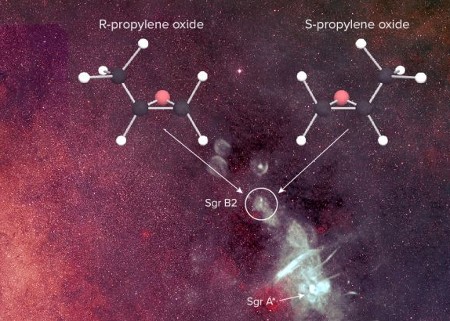April 25, 2020 – Did you know that sugars are right-handed, amino acids left-handed, and the deoxyribonucleic acid (DNA) step ladder helix coils to the right? This commonality is called homochirality. All life as we know it is characterized by this commonality of carbon atoms forming chiral molecules. Amino acids, the basic constituents of ribonucleic acid (RNA), the junior cousin of DNA is a construct built from 40 to 100 nucleotides (molecules of sugar with phosphates and nitrogenous bases (cytosine, guanine, thymine, and adenine).
In space, we find evidence of sugars and amino acids floating among the ten sextillion stars of the observable Universe. In endless collisions, these molecular compounds intersect and join together randomly combining to a point where 40 to 100 form chains. These chains with their right-handed and left-handed opposite characteristics can combine to form the dual helical construct that we know of as DNA. It is this natural homochirality that makes self-replication possible and, therefore, life as we know it. If there is other bases for forms of life unknown to us, it may come from combinations of molecules less or more complex than RNA, and DNA. One cannot rule out, then, that our form of DNA-based life is just one of many other life-creating molecules using left and right-handedness attractors to become self-replicating.
The process by which life spontaneously formed in the Universe is called abiogenesis, the organizing of inanimate and inorganic matter into living things. Most of us who haven’t been reared on a religious diet of life’s biblical origin, think abiogenesis happened here on Earth shortly after the planet formed some 4 billion years ago. But it would appear that the conditions for life to form came from space and not from Earth. This origin of life theory is called panspermia, the migration of life to Earth where it found a hospitable environment conducive for it to take root and expand to the more than 7.7 million species that we know of today.
The panspermia theory comes in several flavours. In one or more it is believed that life hitched a ride to Earth either on comets, asteroids, or on rocks blasted from the surface of other planetary bodies that found their way to the early Earth. Another flavour believes life was deliberately planted here by intelligent beings from elsewhere in the Universe with no explanation on how these beings came into existence. This latter version of panspermia theory aligns with those who believe in biblical creation, but in this case life doesn’t come from God, Creator of the Universe.
For those who argue that panspermia came to Earth from another planet, there appears to be evidence that Mars may have been the seed bearer. Mars in the early Solar System may have been a more benign and suitable place for life than Earth. And with Mars’ orbit positioned outside of Earth’s, it was 100 times more likely that a rock seeded with life would travel inward to the surface of our planet rather than the other way around. These panspermia advocates point to evidence gathered from our exploration of Mars and from a meteorite designated ALH84001, identified as from the Red Planet and found in Antarctica in 1984. Some astrobiologists believe the meteorite shows primitive fossils. Others dispute these conclusions. But from rovers on Mars and orbiters above it, we are building a picture of Mars today and in the past. We have detected organic molecules on the planet’s bone-dry surface, the evidence of surface water from the past, and outgassings of methane that are seasonal in nature. All are promising signs of both ancient and possibly even modern microbial life on Mars.
The latest research on the chemistry of RNA adds credence to the theory of life from space well before arriving on Earth. It suggests that the building blocks of sugars, carbon, phosphates and nitrogenous bases, go back to the very earliest days of the Universe during the period of rapid inflation and coinciding with the birth of the first stars and planets, a mix of interstellar chemistry that evolved post-Big-Bang. The research also indicates the importance of homochirality within the chemistry leading to the molecules RNA, DNA, and possibly even other non-Earth biological constructs producing very different forms of life we have yet to discover.









